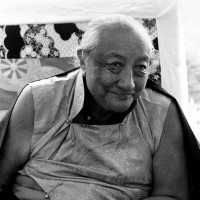Letting the mind to become peaceful and staying in meditation state of stillness free from many thoughts is called shamata or sustained calm. Recognizing the empty nature of the mind within that state of calm is called vipashyana or profound insight. Uniting shamata and vipashyana is the essence of meditation practice. It is said:
Look at the mind,
There is nothing to see.
Seeing nothing, we see the dharma,
The source of all buddhas.

Dilgo Khyentse Rinpoche
from the book The Heart of Compassion: The Thirty-seven Verses on the Practice of a Bodhisattva
translated by Padmakara Translation Group
Read a random quote or see all quotes by Dilgo Khyentse Rinpoche.
Further quotes from the book The Heart of Compassion:
- The three aspects of diligence
- The children of the buddhas
- Opportunity
- The magnifying glass of your faith and devotion
- I like suffering
- The best opportunity to put the teachings into practice
- Meaningless activities without end
- Nothing to be grasped
- No greater obstacle to Dharma practice
- Start observing your mind
- Before it is too late
- Never stop thinking about how to gain liberation
- Sealing your merit with authentic dedication
- No more than an empty echo
- Phenomena adorn emptiness, but never corrupt it
- Giving and taking
- Conduct
- The only thing that is really worth doing
- The reason you are wandering in samsara
- Neither discouragement nor pride